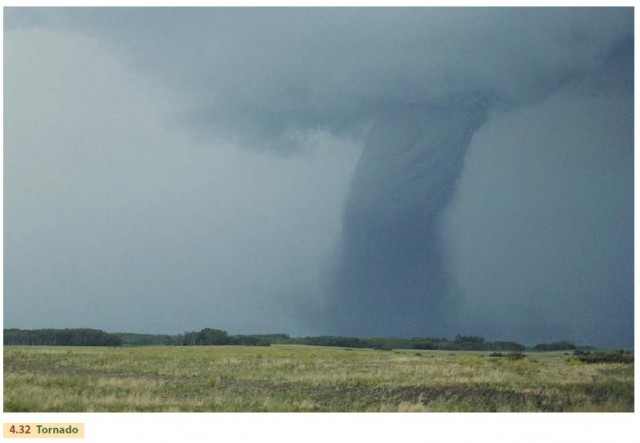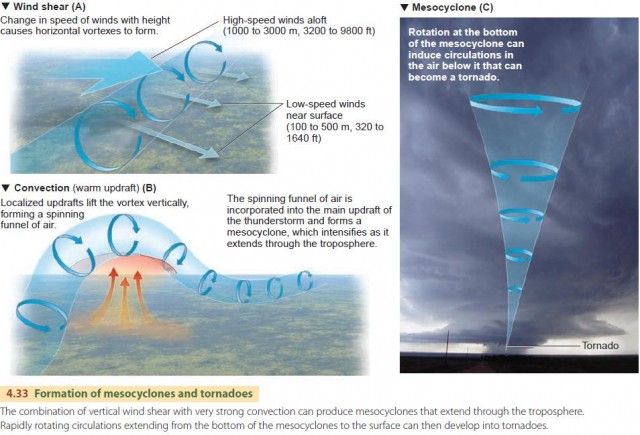Tornadoes
A tornado is a small but intense vortex in which air spirals at tremendous speed. It is associated with thunderstorms spawned by fronts in the midlatitudes of North America. Tornadoes can also occur inside tropical cyclones (hurricanes).
TORNADO CHARACTERISTICS
A tornado, seen in Figure 4.32, appears as a dark funnel cloud hanging from the base of a dense cumulonimbus cloud. At its lower end, the funnel may be 100 to 450 m (about 300 to 1500 ft) in diameter. The base of the funnel appears dark because of the density of condensing moisture, dust, and debris swept up by the wind.
Wind speeds in a tornado exceed speeds known in any other storm. Estimates of wind speed run as high as 100 m/s (about 225 mph), although generally they are closer to 50 m/s (about 110 mph). As the tornado moves across the countryside, the funnel writhes and twists. Where it touches the ground, it can cause complete destruction of almost anything in its path.

The center of a tornado is characterized by low pressure, which is typically 10–15 percent lower than the surrounding air pressure. The result is a very large pressure gradient force that generates high wind speeds as the air rushes into the low-pressure center of the tornado. Most tornadoes rotate in a counterclockwise direction, but a few rotate the opposite way.
TORNADO DEVELOPMENT
Tornadoes are usually associated with the presence of severe thunderstorms, which provide one of the key ingredients in the initial development of the tornado—namely, a very strong vertical circulation. The other key ingredient is the presence of significant change in wind speed and direction with height, termed wind shear (Figure 4.33A). In regions where there is significant wind shear, spinning circulations aligned with the ground—horizontal vortexes—can form. Strong convection can then lift portions of the vortex (Figure 4.33B), which results in a vertical tower of slowly rotating air, called a mesocyclone (Figure 4.33C).

Initially, the mesocyclone is fairly broad. However, as the storm's vertical convection extends the top of the mesocyclone high in the atmosphere, the mesocyclone stretches and narrows. As it does so, it begins to spin faster, much as ice skaters spin faster as they pull their arms close to their bodies. The winds associated with the mesocyclone begin to cause the air below it to spin as well. About a fifth of the time, a narrow, rapidly circulating vortex stretches from the base of the mesocyclone down to the ground. When it touches the ground, it officially becomes a tornado.
TORNADO DESTRUCTION
The large majority of tornadoes are relatively weak, lasting only a few minutes and covering only a few hundred meters. On the other hand, large tornadoes, which make up only about 5 percent of all tornadoes, can last for hours and spread destruction over hundreds of kilometers. Devastation from these tornadoes is often complete within the narrow limits of their paths. Only the strongest buildings constructed of concrete and steel can withstand the extremely violent winds.
The most commonly used measure of tornado intensity is the Fujita intensity scale, or the F-scale. This scale ranks tornadoes from 1 to 5, weakest to strongest. The scale is based on the severity of damage found in the tornado's wake. The more severe the damage, the more intense is the tornado.
In 2007, an enhanced Fujita intensity scale was adopted to better relate the tornado's wind speed to its damage. The new scale now incorporates 28 types of structures, with up to 12 different “degree of damage” ratings for each. This scale allows scientists to compare tornadoes that have passed through very different regions (for example, industrial and rural areas) and better estimate the wind speed within each.
Only about 5 percent of tornadoes reach 4 or 5 on the Fujita intensity scale. However, these tornadoes are responsible for about 70 percent of all tornado deaths. On average, about 75 people in the United States die each year from tornadoes, more than from any other natural phenomena except flooding and lightning strikes.